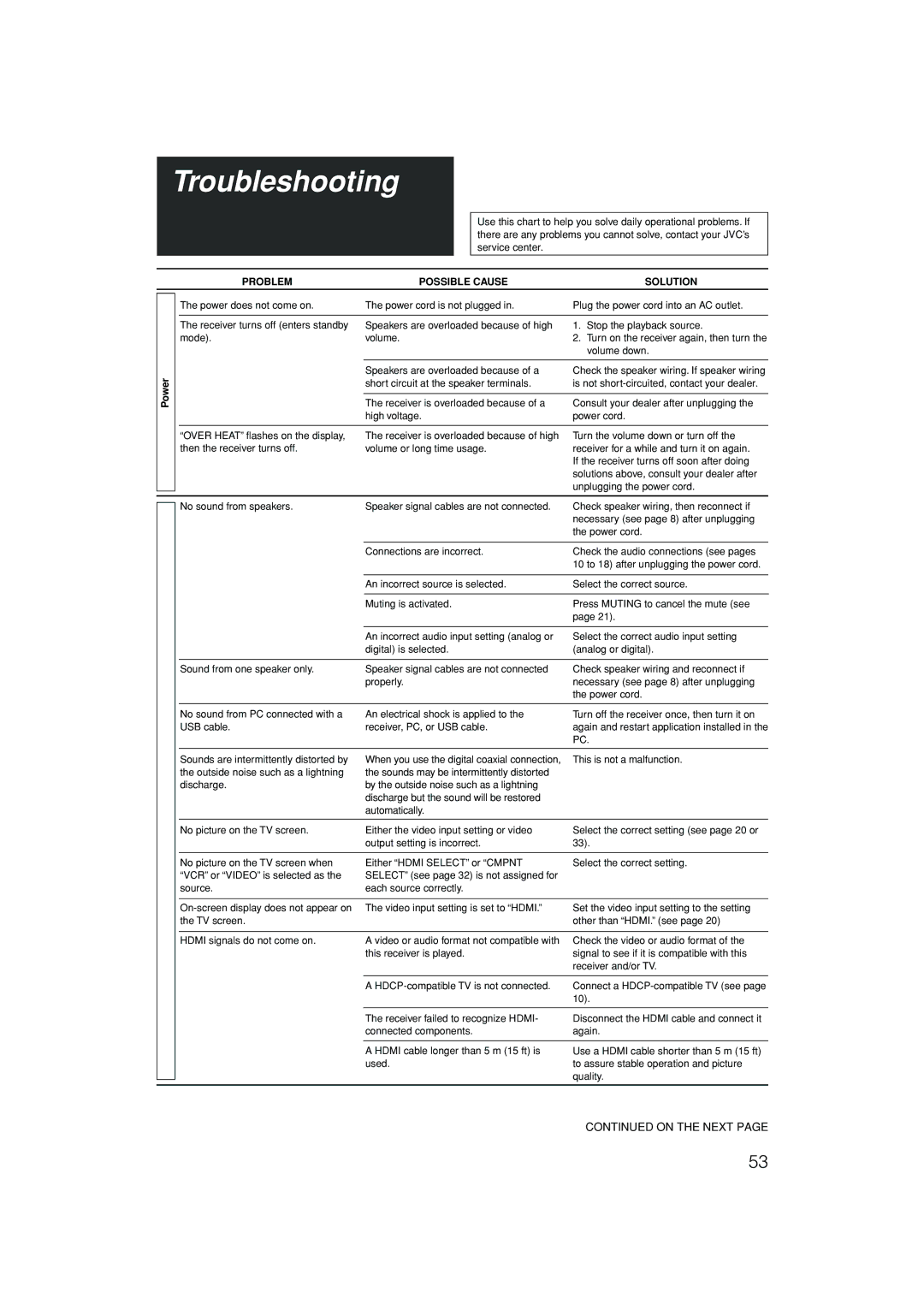
Troubleshooting
Use this chart to help you solve daily operational problems. If there are any problems you cannot solve, contact your JVC’s service center.
Power
PROBLEM | POSSIBLE CAUSE |
| SOLUTION |
The power does not come on. | The power cord is not plugged in. | Plug the power cord into an AC outlet. | |
|
|
|
|
The receiver turns off (enters standby | Speakers are overloaded because of high | 1. | Stop the playback source. |
mode). | volume. | 2. | Turn on the receiver again, then turn the |
|
|
| volume down. |
|
|
| |
| Speakers are overloaded because of a | Check the speaker wiring. If speaker wiring | |
| short circuit at the speaker terminals. | is not | |
|
|
| |
| The receiver is overloaded because of a | Consult your dealer after unplugging the | |
| high voltage. | power cord. | |
|
|
| |
“OVER HEAT” flashes on the display, | The receiver is overloaded because of high | Turn the volume down or turn off the | |
then the receiver turns off. | volume or long time usage. | receiver for a while and turn it on again. | |
|
| If the receiver turns off soon after doing | |
|
| solutions above, consult your dealer after | |
|
| unplugging the power cord. | |
No sound from speakers. | Speaker signal cables are not connected. | Check speaker wiring, then reconnect if | |
|
| necessary (see page 8) after unplugging | |
|
| the power cord. | |
|
|
| |
| Connections are incorrect. | Check the audio connections (see pages | |
|
| 10 to 18) after unplugging the power cord. | |
|
|
| |
| An incorrect source is selected. | Select the correct source. | |
|
|
| |
| Muting is activated. | Press MUTING to cancel the mute (see | |
|
| page 21). | |
|
|
| |
| An incorrect audio input setting (analog or | Select the correct audio input setting | |
| digital) is selected. | (analog or digital). | |
|
|
| |
Sound from one speaker only. | Speaker signal cables are not connected | Check speaker wiring and reconnect if | |
| properly. | necessary (see page 8) after unplugging | |
|
| the power cord. | |
|
|
| |
No sound from PC connected with a | An electrical shock is applied to the | Turn off the receiver once, then turn it on | |
USB cable. | receiver, PC, or USB cable. | again and restart application installed in the | |
|
| PC. | |
|
|
| |
Sounds are intermittently distorted by | When you use the digital coaxial connection, | This is not a malfunction. | |
the outside noise such as a lightning | the sounds may be intermittently distorted |
|
|
discharge. | by the outside noise such as a lightning |
|
|
| discharge but the sound will be restored |
|
|
| automatically. |
|
|
|
|
| |
No picture on the TV screen. | Either the video input setting or video | Select the correct setting (see page 20 or | |
| output setting is incorrect. | 33). | |
|
|
| |
No picture on the TV screen when | Either “HDMI SELECT” or “CMPNT | Select the correct setting. | |
“VCR” or “VIDEO” is selected as the | SELECT” (see page 32) is not assigned for |
|
|
source. | each source correctly. |
|
|
|
|
| |
The video input setting is set to “HDMI.” | Set the video input setting to the setting | ||
the TV screen. |
| other than “HDMI.” (see page 20) | |
|
|
| |
HDMI signals do not come on. | A video or audio format not compatible with | Check the video or audio format of the | |
| this receiver is played. | signal to see if it is compatible with this | |
|
| receiver and/or TV. | |
|
|
| |
| A | Connect a | |
|
| 10). | |
|
|
| |
| The receiver failed to recognize HDMI- | Disconnect the HDMI cable and connect it | |
| connected components. | again. | |
|
|
| |
| A HDMI cable longer than 5 m (15 ft) is | Use a HDMI cable shorter than 5 m (15 ft) | |
| used. | to assure stable operation and picture | |
|
| quality. | |
CONTINUED ON THE NEXT PAGE
53
